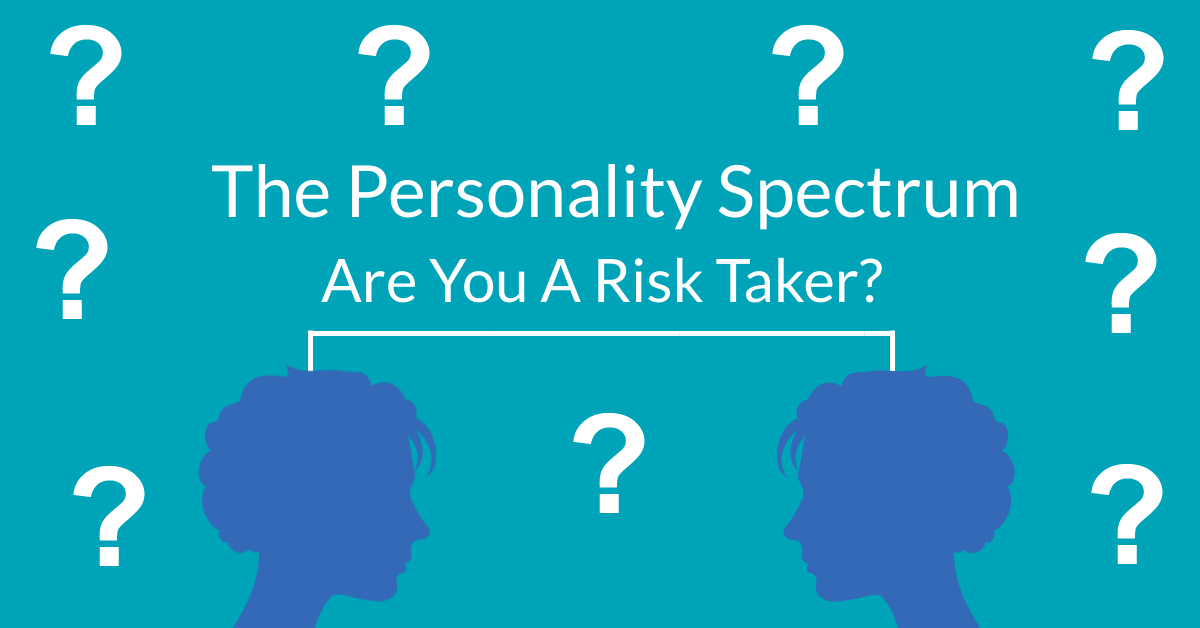Science is increasingly telling us that we have multiple personalities on a personality spectrum. There are multiple versions of ‘you’ inside your own head. Whichever personality ‘you’ are depends on many different circumstances – such as what mood you are in, the environment you are in, or the company you keep.
This is known as the multiplicity spectrum. The ‘multiplicity spectrum’ helps to determine the degree of separation between personalities.
How multiple are you? Take the risk taker personality quiz
How many personalities do you have? Take our are you a risk taker quiz and find out. We would recommend taking this along with somebody who knows you well – and giving them perhaps the final say in how you answer a particular question.
How did you do? Here’s what each score on our risk personality test quiz means:
0 – 7
A score this low is uncommon but by no means bad. It suggests that, unlike most people, you don’t have multiple personalities. With a score this low, there are two possibilities:
- Either you have a very unified self, a ‘singular’ personality.
- The ‘You’ who has completed the quiz is unable to see the ‘other’ personalities you have and is just answering for itself.
8 – 23
Most of the general population score somewhere in the middle, between 8 – 23 points. (My score was within this range.) Most of us have varied personalities that change by the hour and even slowly, over a period of months.
24+
A score this high on the risk taking quiz puts you well into the ‘multiple’ personality end. Don’t be alarmed. This is not bad news — it can even be a good thing.
The multiplicity spectrum can be visualised. Below is a ‘landscape’ of the mind. It looks a bit like a flat field rising into a mountain range. The flat line represents the uniform, steady personality of the low scorer. The middle is a bit of most of us — flat sometimes but a bit rocky. Towards the higher end, multiple personalities abound — represented as jagged and disconnected lines. The multiple personality quiz you have just taken is quite good at revealing this ‘landscape’.

We may not manifest entirely different characters in our personalities, but we have fluctuating moods. We might refer to our ‘reckless’ side, ‘obsessive streak’, or the ‘food addict’ inside of us.
Identifying your personality: The “Big Five”
In the 1930s, psychologists compiled a list of over 18,000 words describing human behaviour from all over the world. It would take until the nineties before the list was narrowed down to just five words. In psychology, these five words are known as the “Big Five“.
They are:
Openness. This trait refers to the degree a person seeks and appreciates new, interesting, and novelty experiences. It generally represents curiosity and broad-mindedness. ‘Open’ people get bored easily, but are creative, funny, and imaginative. They have rich inner lives and like new ideas. They also tend to make good hypnotic subjects.
Conscientiousness. This trait tends to represent how goal-aligned and organised a person is. Conscientious people are well disciplined, reliable, hard-working, and will forego short-term rewards for long-term success. There’s even evidence to suggest conscientious people live longer because they abstain from high-risk endeavours.
Extroversion. An extrovert needs stimulation from the outside world, from other people, and from things around them in general. It should be no surprise to learn that extroverts tend to be a fun, impulsive, and extraordinarily happy bunch who love the company of others. Extroverts are natural born leaders and multi-tasking is often a great strength. They also drink more, have more sexual partners, and are more likely to cheat on their partners.
Agreeableness. An agreeable person generally cares a lot about others. They tend to be trustworthy, kind, affectionate, and likeable. They are more likely to be promoted at work, less likely to split from a partner, and perform very well in job interviews.
Neuroticism (Uptight). The fifth and final of the Big Five is measured by how emotionally stable a person is. A person who is highly neurotic is prone to worry, has low self-esteem, sets unrealistic goals, and may be overly dependent on a partner. Neurotics also experience jealousy, envy, and distress fairly typically.
These five traits or ‘dimensions’ and their risk taker opposites can be viewed visually on the ‘Personality Wheel’:

At the other end of the scale: the Big Five in reverse
With the Big Five, we can identify the cornerstones of personality. Looking at them, we can also look at their opposites:
Conservative. Conservative personalities tend to be more conventional, down to earth, and more practical. They tend to work through problems carefully, on a step-by-step basis and are more comfortable with familiar places, faces, and food.
Careless. Unsurprisingly, a careless personality attitude is one that is less reliable, harder to motivate, and easily distracted. A careless personality does have some positives, however. They are easy going and can be flexible and adaptable to rapidly changing circumstances.
Introversion. Introverts tend to be more controlled and reserved and consider how they appear to others a great deal more. They may have a small, but tight-knit group of friends. If an introvert had to choose between a night on the dancefloor or a quiet night in with a book, it’d probably be the latter. Introverts are more sensitive to pain, but they are good at working on single tasks. Generally, they prefer to work in an intimate environment with few distractions.
Disagreeableness. A disagreeable personality is unsurprisingly perceived as aggressive, mean, and uncooperative. They tend to see things from their point of view only and prefer being right over caring for people’s feelings. Disagreeable traits can be good in areas that require tough decision-making because they are less likely to be taken advantage of by others.
Stability. Stable people — the opposite of neurotic — tend to be calm, extremely relaxed, and emotionally secure. They are largely unphased by negative events and may even thrive on stress. Really stable people are resilient in the face of failure, and cope well with the bad things life throws at them.
Personality and the spectrum of risk
If you’re a risk manager, have your project team map out their personalities and look at the results. Depending on how they score a few things will stand out to you. Namely:
Conscientiousness = reliable, the opposite of a risk taker.
Extroverts = natural born leaders; good at multi-tasking (an invaluable skill for managing multiple risk management projects). The downside is the need for instant gratification, especially because risk management should be proactive about planning ahead, and not reactive.
Conservative = more practical; analyse things carefully on a step-by-step basis.
Introverts = very good at single tasks, especially if left alone.
Stable people = less unphased by negative psychology
Disagreeableness = dangerous, but less likely to “fall in with the crowd”. More likely to speak their minds, thereby breaking the chain of groupthink. Likely not to be afraid to contribute new ideas or challenge affirmed notions.
This is all well and good. But the problem, we have seen, is that most people have many personalities. An employee may be disagreeable and conscientious one day, and then disagreeable and extroverted the next.
This can have important ramifications for people’s attitudes to risk. How then, do you know which of the personalities it is your team members are embodying at any one time? What if they are prone to off-days, where they sometimes fail to hit their targets — like second rate snooker players? And what if a team member displays an entirely different personality at least some of the time?
Discovering your personalities
The Big Five have proven to be really economical and accurate at categorising our personalities. But in order to figure out where a personality lies in each of these personality dimensions, your employees will need to do a lot of questioning. In order to do this, the opposites of the Big Five are also useful. This is what you will find on the Personality Wheel (above).
The Personality Wheel was first developed by the psychologist Rita Carter. The idea of the Personality wheel is not to examine your personalities as individuals. Rather, it is to survey the general layout of your inner landscape – the landscape of the mind that we pictured above.
Take a look at each of the lists below. You will see each of the Big Five and their opposites are broken into smaller categories. For example under the first list, ‘Open-Minded’ is broken into ‘Creative’, ‘Questioning,’ and so on.
Open-Minded
- Creative
- Questioning
- Artistic interests
- Emotionally open
- Adventurous
- Tolerant
- Romantic
- Playful
Extrovert
- Talkative
- Socially bold
- Energetic
- Companionable
- Assertive
- Polite
- Thrill-seeking
- Enthusiastic
Stable
- Even-tempered
- Satisfied and/or content
- Relaxed
- Optimistic
- Self-accepting
- Calm
- Laid-back
- Self-sufficient
Agreeable
- Warm
- Kind
- Co-operative
- Trusting
- Friendly
- Open
- Forgiving
- Teamworker
Conscientious
- Organised
- Efficient
- Methodical
- Dutiful
- Tenacious
- Dependable
- Hard working
- Responsible
Conservative
- Uncreative
- Unquestioning
- Not really art interested
- Emotionally closed
- Routine-bound
- Intolerant
- Unromantic
- Conventional
Introvert
- Shy
- Quiet
- Not very energetic
- Withdrawn
- Reserved
- Impolite
- Timid
- Reclusive
Uptight
- Moody
- Jealous
- Touchy
- Anxious
- Depressed
- Angry
- Tense
- Dependent
Disagreeable
- Cold
- Rude
- Stubborn
- Critical
- Quarrelsome
- Distant
- Distrustful
- Obstructive
Careless
- Disorganised
- Sloppy
- Inefficient
- Reckless
- Immature
- Unreliable
- Rebellious
- Irresponsible
The personality wheel is designed to detect and amplify the inconsistencies that reveal our different personalities, and these sub-categories are there to flesh out the personalities of your team members in greater detail.
But how do we even begin to study our ‘other’ personalities? How do I see beyond the personality that is currently ‘me’ and how do you see beyond what is currently ‘you’?
You can essentially “play” the part of a personality. Start by getting your employees into a neutral frame of mind and getting them to imagine what they are like in certain situations. Old photographs that trigger memories can help with this. For example, if one of your personalities is you as a parent, then looking at photographs or thinking about your children can help this side of ‘you’ come out.
Likewise, if you are trying to capture a rowdy personality that comes out with friends, let your team mates gossip with one another, or have them call a friend from outside of work.
Have them identify the major personalities that ‘take the stage’ the most. Here are a few examples to get you going:
- How they might behave when they are at work
- How they might feel doing something they really enjoy (dancing, for example)
- How they might behave on a holiday with friends
The chances are, your employees don’t act the same in the office as they would in work — and that’s OK! But they are both personalities.
Did you know? Most people think they have one ‘real’ personality — whichever personality is the most dominant — and consider the rest to all be minor personalities.
Plotting your personalities
span style=”font-size: large;”>For this example, I’m going to say I’m at home and I want to know what I’m like in work. I want to know how my work personality equips me for the world of risk management. In order to do this, I will look at each of the sub-categories in the tabs above.
Going through each of the sub-categories, I will tick off which of them apply to me. Even though I’m an agreeable person, it’s unlikely I am going to tick off all of the sub-categories under Agreeable. For example, I might think I’m kind but also critical (which is a disagreeable quality). Because the sub-categories of ‘Agreeable’ and ‘Disagreeable’ are polar opposites, it’s virtually impossible I will tick off most of the sub-categories in both.
Once I’ve gone through the exercise, I will count up the number of ticks, and make a note of how many of them are under which tab. Then I will go to my personality wheel, and ‘score’ my personality.
For example, I like to think I’m pretty open-minded, so I ticked off five sub-categories under that tab. I also like to think I’m a bit of an extrovert; comfortably stable, moderately agreeable and highly conscientious. Here’s what my personality wheel looks like.

Notice how my personality wheel is shaped by the score points I gained by ticking off the relevant sub-categories. I found that my work ‘self’ is highly conscientious — a good thing for managing risk — scoring maximum points. The same goes for stability and open-mindedness.
It is also a bit jagged — even for what I consider one of my most solid personalities. This backs up my results from the quiz, putting me squarely in the middle like most of the general population. The next step would be to repeat this process again, with all of the personalities I believe to carry with me through my personal life. I suspect different situations — going out with friends, for example, to skew my score in other directions. That’s perfectly normal.
Again, a test like this should be carried out with a trustworthy person. After all, I may have an idealistic impression of my work self. A colleague whom I trust might be required to knock me down a peg. This also doubles-up as a good team-building exercise among your employees to help foster trust and establish lines of communication.
Identifying yourself — and being a better person for it
After decades of research, most psychologists now believe the complexity of human personalities to be an illusion. They really can be summed up with the Big Five and their opposites.
In everyday life, most people vary across just the five dimensions. If you learn to understand these dimensions, then you can gain an important insight into how your employees behave and think on a month-to-month, week-to-week, day-to-day — even hourly basis.
By plotting out your personalities you can quickly learn ‘Are you a risk taker?’ and where your weaknesses lie and manage them — and so can your team members. This includes even your major personality, the ‘you’ you experience most of the time. Even this personality — like every other — should be tested on different days, and at different times. You’ll be surprised to see how it changes.
The personality wheel relies primarily on you and your employees remembering how they behave in certain roles. Some of our personalities feel more apparent than others: some are well-defined, and others are more intuitive and feely.
The personality wheel is useful to keep a hold of. If you have troublesome ‘minor’ personalities, like carelessness, you can carefully track that vice as it appears. This can be an invaluable team-building exercise and pro-active measure for any team working on a project together.
By identifying your vices, those minor personalities that can cause trouble, you and your teammates can learn not to take risky chances. Learning involves a physical change to the structures of the brain. It can be difficult to re-learn new behaviours, but it is not impossible.
Here are some tips for getting the most out of a Personality Wheel. Have your team:
- Find the time.
- Create a relaxing, peaceful atmosphere.
- Do it regularly.
- Have an open mind.
Print off your very own Personality Wheel here, and get started mapping our your personalities. What we need to do is learn to recognize when these personalities are coming about – the ones that make us likely to take a risk – and control them. Or to identify those who are at risk. The control is that there is a way to unlearn bad habits and identify which ‘personality’ — risk taking personality or not — is currently in charge.
Good luck.
For more risk management processes, methods, and tips, check out our homepage, our blog, and feel free to contact us if you have any questions.


